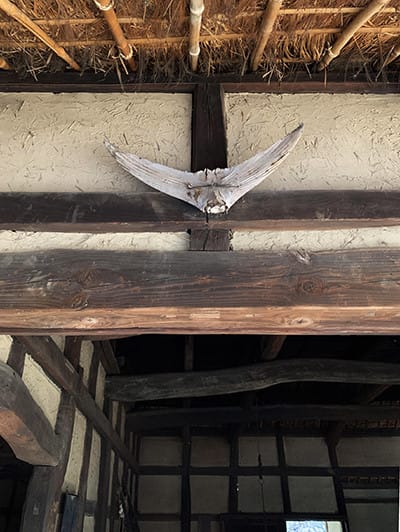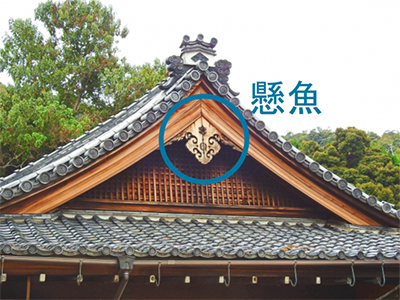

さて、5回にわたった川崎市北方・多摩に近い古民家を見てきましたが、
最後にふしぎな飾り物を見て、はたと当惑してしまった。
あえていえば「懸魚」〜げぎょ〜なのかなぁと思われた。
一般的に知られる懸魚は以下のような理解。
〜建築装飾の一つ。 中国や日本の建築で破風の下部内側またはその左右に
六葉といわれる金属製や木製の栓で取付け、棟木や桁の先を隠すための飾り板。
形により梅鉢懸魚,猪目懸魚,かぶら懸魚,三花懸魚などの種類がある。〜
この飾り物は平入りの玄関上に据えられていたので、
なにかのまじないの一種ではあろうと思われた。しかし、
いわゆる懸魚というのはこんなのが一般的イメージ。

あくまでの木彫品であって、建築意匠として様式化されているのが常識。
およそ350年前くらいの建築年代の農家住宅なので、
様式化以前の生々しいまじない要素が素で表されているもののように感じた。
ブリタニカ国際大百科事典には「当初魚をつるしたような形であったので
この名がある」というように記載されていた。
ということは、民俗信仰として家屋の災い除け、最大は火災だろうから、
水にまつわる魚が象徴化されて、このようにピンナップされたのか。
350年前当時でも様式化された懸魚は存在していただろうけれど、
民俗としては、このようになまなましい魚のシッポが生け贄のように捧げられたか。
大きさは柱の寸法から類推して、左右幅で50-60cmはあるのではないか。
海生の大型魚類、あるいはサメくらいの魚種のような気がする。
というより、サメのような獰猛なヤツがふさわしいのではないかと妄想した。
なかなかワイルドでいい。
上品に様式化された、いわば去勢された信仰よりも、
民の即物的息吹、息づかいが伝わってくる気がする。
上級建築や仏閣などとは違う、民のリアルな感受性として納得感。
近くには多摩川が流れているけれど、川を下ればすぐに相模湾。
活発な水上交通の交流を考えれば、大型海生漁の香りが薫ってくる。
あるいはこの家の新築祝いに相模湾海岸地域の住人が
この魚の1匹まるまんまを持参してくれて、その身をたっぷりと一同で平らげ、
なお、残った見事な尾びれをありがたく神にお供えする意味で
玄関先の魔除けとしたのかも知れない。
ありがたく食べさせていただいた上に、さらに魔除けとして奉仕する、
巨大魚としても甲斐があったのではないか。
・・・というような空想・夢想にしばし浸っておりましたが、さて。
こういう習俗について情報をお持ちの方、ぜひお教えください。
English version⬇
[Is this the prototype of "hanging fish"? ]
By the way, I have seen an old folk house near Tama in the north of Kawasaki City five times.
At the end, when I saw the mysterious decoration, I was confused.
If I dare to say it, I wondered if it was a "hanging fish".
Generally known hanging fish have the following understanding.
~ One of the architectural decorations. Inside or to the left and right of the lower part of the gable in Chinese and Japanese architecture
A decorative board that is attached with a metal or wooden stopper called Rokuyo to hide the purlins and girders.
Depending on the shape, there are types such as plum pot hanging fish, inome hanging fish, turnip hanging fish, and three flower hanging fish. ~
This decoration was placed on the flat entrance, so
It seemed to be a kind of magic. But,
The general image of so-called hanging fish is this.
It is common sense that it is a wooden carving to the last and is stylized as an architectural design.
It's a farmhouse that was built about 350 years ago, so
I felt that the elements that were not raw before stylization were expressed in plain text.
The Britannica International Encyclopedia says, "Because it was initially shaped like a fish.
There is this name. "
That means that as a folk religion, the disaster of the house can be avoided, and the biggest is the fire.
Was the fish related to water symbolized and pinned up like this?
There would have been stylized hanging fish 350 years ago,
As a folklore, was such a graceful fish tail sacrificed?
By analogy with the dimensions of the pillars, the size may be 50-60 cm in width.
It feels like a large marine fish or a shark-sized fish species.
Rather, I wondered if a ferocious shark-like guy would be suitable.
It's pretty wild.
Rather than an elegantly stylized, so to speak, castrated faith
I feel that the real breath and breath of the people are transmitted.
It is convincing as the real sensitivity of the people, which is different from high-class architecture and temples.
The Tama River runs nearby, but Sagami Bay is just down the river.
Considering the active exchange of water transportation, the scent of large marine fishing is fragrant.
Or a resident of the Sagami Bay coastal area to celebrate the new construction of this house
Bring me a whole manma of this fish and flatten it all together.
In addition, in the sense of offering the remaining splendid tail fin to the god thankfully
It may have been a talisman at the front door.
Thank you for eating, and also serve as a ward off.
I think it was worth it as a giant fish.
I was immersed in fantasies and dreams like ... for a while, but now.
If you have any information about these customs, please let us know.



















